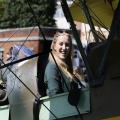BACK IN March 1993 a local resident, Esme Timms, wrote a piece for the Bicester Advertiser detailing her memories of the town she had known all her life.
Looking back on it now gives us a glimpse of both the period she is writing about and the time when it was written.
We can easily see how much the town centre had changed over those sixty years, and again over the twenty-six years to today.
She writes:
The 1920s and 1930s were hard times for the majority of working people, and for some there was grinding poverty. Though families seemed to help and support each other in times of need.
St John’s Street once boasted a pub, The Star Inn - the landlord being my father Harry Clifton - which stood on the site of what is now Franklin’s Yard car park.
Our street consisted of various little alleyways — the houses and cottages were built to form a square to serve as an open space.
Some of the homes were called Franklin’s Yard and Ladysmith Terrace. They were demolished in 1967 to create the car park.
Another alleyway led to land where the Bure meandered through Coker-owned Bicester House spinney, now Manorsfield Road and Bure Place.
The water came from a natural spring in Bell field, now Queen’s Avenue. This was known as Spring Close.
There was always a carnival in the summer and I remember the 1936 Jubilee Celebrations of King George V and Queen Mary when a party was held in the old brewery tun room down the Causeway.
The brewery was demolished along with other properties in the late 1960s. The site is now occupied by the National Westminster Bank and other shops.
The town had two cinemas, the Regal in London Road where we enjoyed Saturday morning films (entrance fee tuppence) and where serials were shown such as Rin-Tin-Tin, The Clutching Hand, and Tom Mix, our Western hero.
A couple named Smith managed the cinema and they must have dreaded Saturdays, we were such a rowdy lot.
The other cinema was at the back of the lovely 16th century Crown Hotel which stood at what is now the Sheep Street entrance of Crown Walk.
There were plenty of sweet shops in the town where we could spend our “Saturday penny”.
Mrs Godfrey, Mrs Jackson, Miss Broad and Millie Bourton’s — the latter being on the corner of Bell Lane, almost exactly where the two telephone kiosks are today.
Little front parlours were used as shops (no need for planning permission in those days) and what an appropriate name little Mrs Cherry chose for her shop, The Handy Stores — now a bigger store but still run by members of her family.
Further down Sheep Street was Stanford’s fruit shop, which is now occupied by Foster’s menswear.
We could make a little pocket money if we liked, to pick blackberries and sell him the fruit.
Down on Market Square was Miss Scrivener in her wool and toy shop, which had a trap door in the floor leading to her store room. When she went down into the cellar for anything we waited with bated breath, wondering if she was ever coming up again. She always did.
I also recall the brisk and dapper Mr Wheeler, the manager of the International Stores, a site now occupied by the Lemon Plaice fish and chip shop. His daughter, Verity, was our Sunday School teacher.
The Second World War brought many changes. The Ordnance Depot came and servicemen and women from all over the world were stationed here.
What could they know or care about our funny little town or its past.









Comments: Our rules
We want our comments to be a lively and valuable part of our community - a place where readers can debate and engage with the most important local issues. The ability to comment on our stories is a privilege, not a right, however, and that privilege may be withdrawn if it is abused or misused.
Please report any comments that break our rules.
Read the rules hereLast Updated:
Report this comment Cancel